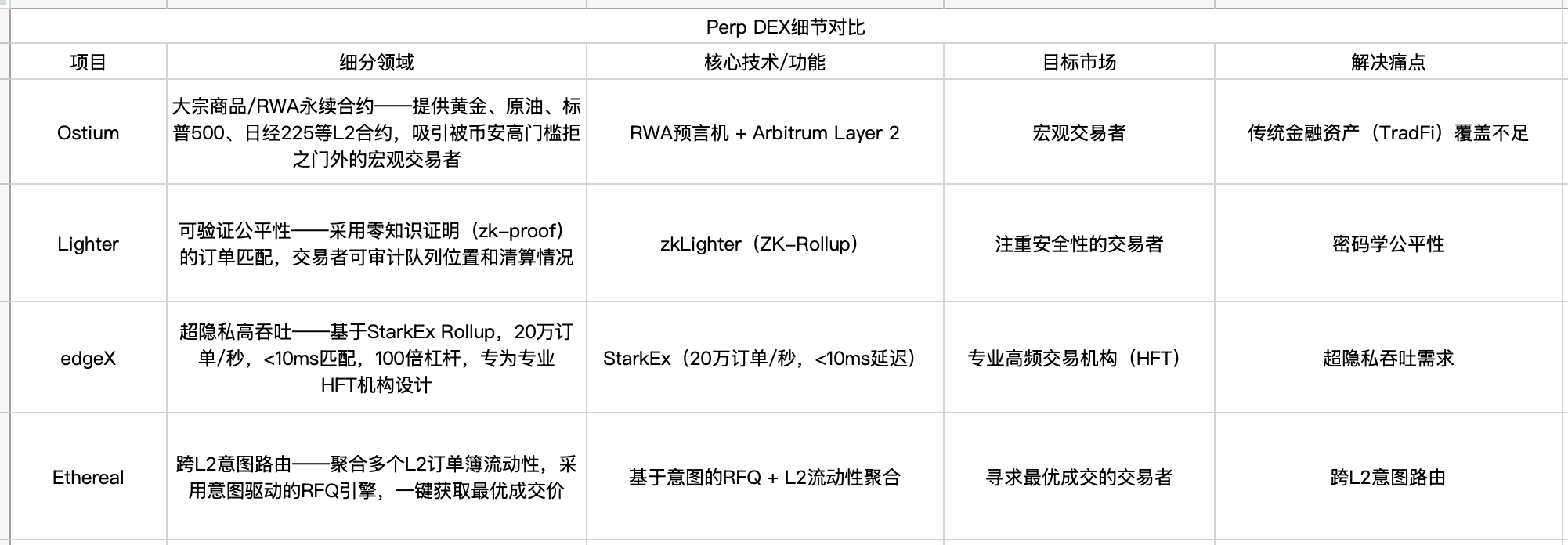A differentiated overview of the eight new generation Perp DEXs. Who can break out of the second half of the contract competition?
This article comes from: arndxt
Compiled by Odaily Planet Daily ( @OdailyChina ); Translated by Azuma ( @azuma_eth )
Editor's note: Decentralized perpetual contract exchanges (Perp DEX) have become the most popular track in the industry. Although Hyperliquid's leading position is looming, more new generation Perp DEXs are also coming in force. In the following, cryptocurrency analyst arndxt conducted a differentiated analysis of the core highlights of multiple rising stars in the Perp DEX track, covering eight projects including Vertex, Drift, GMX V2, Kwenta, Aevo, Ethereal, Ostium Lighter, and edgeX , which may help investors find potential alpha in this track.
The following is the original content of arndxt, translated by Odaily Planet Daily.

The rise of decentralized perpetual contract exchanges (Perp DEX) is inevitable because they eliminate the possibility of centralized platforms collapsing from an economic mechanism perspective.
The current technical architecture is trending towards a design that completely eliminates the risk of fund custody while retaining the Binance-level user experience. The next 12 months will be a critical period for the development of this track. The winners will be able to monopolize liquidity by optimizing the design structure, while the losers will only become another mediocre project supported by token incentives.
Necessary design mission
The collapse of FTX in November 2022 interrupted the development trend that was once tacitly accepted by the industry - exchanging fund custody rights for speed and liquidity. Suddenly, the speed of execution seemed meaningless in the face of the security of the funds themselves.
However, the first generation of Perp DEX (such as GMX V1 and Gains) is too slow and rigid to compete with centralized exchanges (CEX) in terms of execution quality. The gap between "CEX-level speed" and "DeFi-level security" has become a core problem that the industry needs to solve urgently.
Today, a large number of new Perp DEXs are responding to this problem head-on. Their transaction matching speeds are generally less than 10 milliseconds, funds are settled entirely on-chain, and user funds are never managed.
Liquidity is gathering around order book engines (not vAMM models). Whoever can first break the $1 billion to $5 billion daily trading volume threshold will be able to build a moat - arbitrageurs and copy trading robots will take root here.
In addition to the hotly discussed Lighter and Ostium, Ethereal is also worth paying attention to. If its team can achieve a matching speed of less than 5 milliseconds and remain non-custodial, it may become the first "high-frequency trading-level" DEX with direct access to intent routing (rather than isolated order books).

How newcomers build moats
It is becoming increasingly clear that the competitive dimension of the new generation of Perp DEX is not only trading volume, but also intentional trading, in-depth cultivation of vertical scenarios, and filling in systemic gaps that industry leaders such as Hyperliquid have not yet solved.
Against this background, the development strategy of the new Perp DEX is very clear - first identify the trading needs that Hyperliquid fails to meet, then build a dedicated execution layer around it, and then use new technical primitives that were not feasible two years ago as core support.
Currently, the following projects are targeting the blank areas that Hyperliquid has not yet covered:
Ostium: Traditional financial assets (TradFi Assets);
Lighter: Cryptographic Fairness
edgeX: Ultra-Private Throughput;
Ethereal: Cross-L2 Intent Routing;

When evaluating the development status of major Perp DEXs in the third quarter of 2025, I tend to use differentiated order flow (rather than pure trading volume) as the core rating metric.
Hyperliquid: Still the undisputed king, looking forward to the second season airdrop.
Vertex Protocol + Drift Protocol: Pioneer in cross-margin trading on two of the fastest blockchains (Arbitrum and Solana).
edgeX + Lighter: Once zk-proof throughput is tested in practice, it may become an institutional choice.
Ostium: A dark horse player, the notional trading volume of RWA perpetual contracts may crush native crypto assets.
Traditional vAMM-type Perp DEX (GMX, Gains): It still has a strong retail investor base, but it must launch an order book, otherwise it will inevitably lose trading volume.



